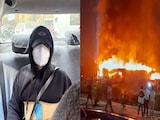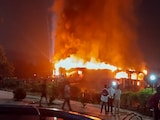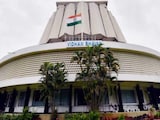Delhi's air quality deteriorated on Diwali, with 34 out of 38 monitoring stations recording pollution levels in the 'red zone' on Monday, indicating 'very poor' to 'severe' air across the national capital.
Delhi's 24-hour average air quality index (AQI), which is reported at 4 pm every day, remained in the 'very poor' category at 345, higher than the 326 recorded on Sunday, according to official data.
According to the SAMEER app developed by the Central Pollution Control Board (CPCB), four monitoring stations were already in the 'severe' category with AQI levels above 400 -- Dwarka (417), Ashok Vihar (404), Wazirpur (423) and Anand Vihar (404).
Around 30 monitoring stations reported 'very poor' air, with AQI levels above 300.
In the afternoon, 31 out of 38 stations recorded 'very poor' air quality, while three stations fell under the 'severe' zone, data showed.
The air quality is expected to slip into the 'severe' category more widely on Tuesday and Wednesday.
The CPCB categorises AQI between 0 and 50 as 'good', 51 and 100 'satisfactory', 101 and 200 'moderate', 201 and 300 'poor', 301 and 400 'very poor', and 401 and 500 'severe.' Transport emissions contributed 15.6 per cent to Delhi's air pollution on Monday, while other factors, including industries, accounted for 23.3 per cent, data from the Decision Support System (DSS) showed.
On Sunday, the Commission for Air Quality Management (CAQM) invoked Stage II of the Graded Response Action Plan (GRAP) across Delhi-NCR.
The move followed a review of the sub-committee on GRAP on Saturday and forecasts by the India Meteorological Department (IMD) and the Indian Institute of Tropical Meteorology (IITM).
On October 15, the Supreme Court allowed the sale and bursting of green firecrackers in Delhi-NCR between 6 am and 7 pm and again from 8 pm to 10 pm on Diwali eve and the day of the festival.
(Except for the headline, this story has not been edited by NDTV staff and is published from a syndicated feed.)















